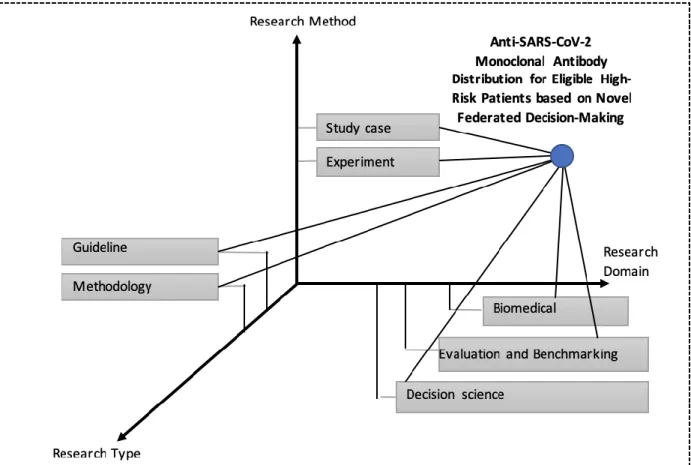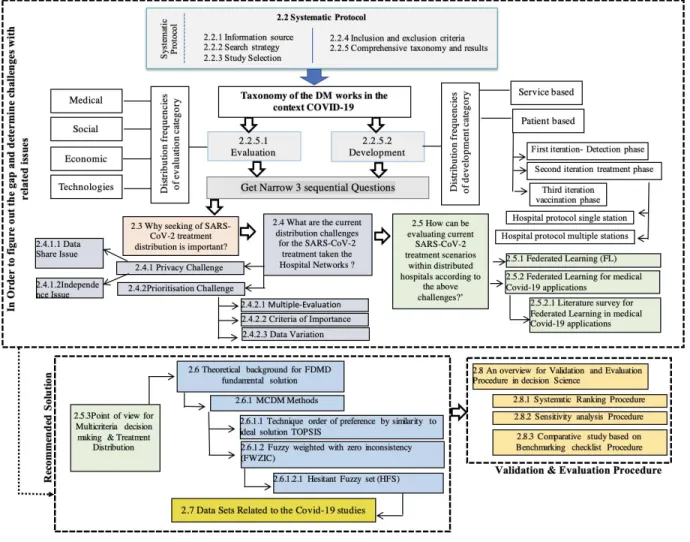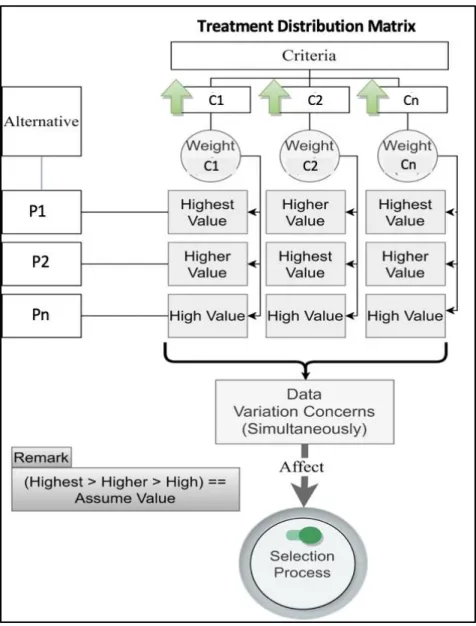لا تقلق ، لا تقلق ، لا تقلق ، لا تقلق ، لا تقلق ، لا تقلق. من فضلك عد إلى المطار ، لا تذهب إلى الجحيم ، دعنا نذهب إلى العمل ، دعنا نذهب إلى المستشفى.
INTRODUCTION
- Introduction
- Background
- Problem statement
- Research Questions
- Objectives of the research
- Relationship between research questions, research objectives and research problem
- Scope of the research
- Significance of the study
- Thesis layout
What are the criteria used in the evaluation and benchmarking of the most suitable patients for the distribution of anti-SARS-CoV-2 monoclonal antibodies. A new FDMD methodology was developed for prioritizing the most appropriate high-risk patients from various hospitals and distribution of anti-SARS-cov-2 monoclonal antibodies.
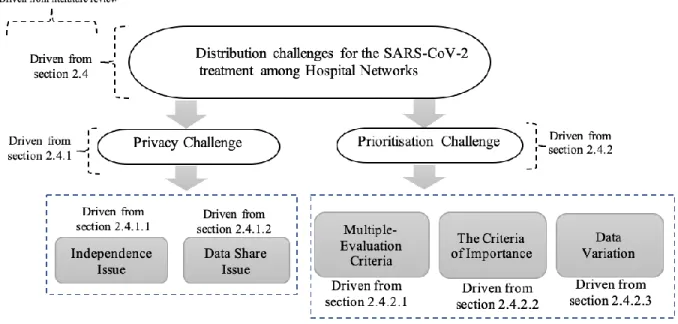
LITERATURE REVIEW
Introduction
Systematic Literature Review Protocol
- Information Source
- Search strategy
- Study selection
- Inclusion and exclusion criteria
- Comprehensive Taxonomy and Results
- Evaluation 25
Further research conducted by Wan et al. 2021) found to be essential for selecting appropriate hospitals in the event of a COVID-19 outbreak. In the social subcategory, four studies emphasized the assessment of the social perspective in the context of COVID-19.
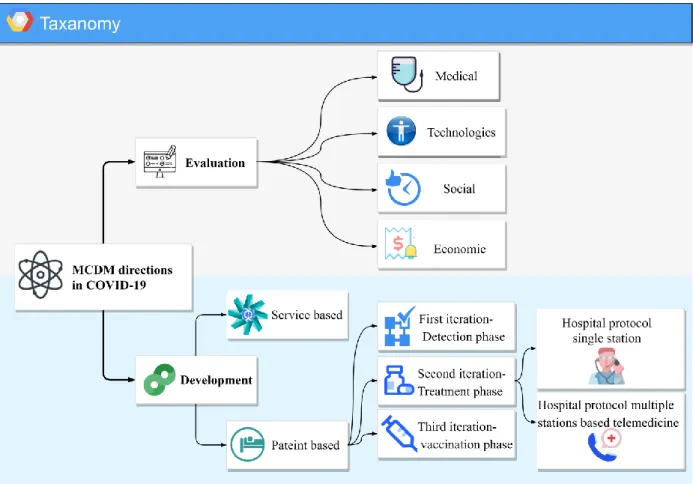
Why seeking of SARS-CoV-2 treatment distribution is important?
4 Schematic illustrating immune system response and therapeutic combination of anti-SARS-CoV-2 mAbs during infection. Therefore, the development and widespread distribution of SARS-CoV-2 medicinal treatments is significant (Bollyky et al., 2020).
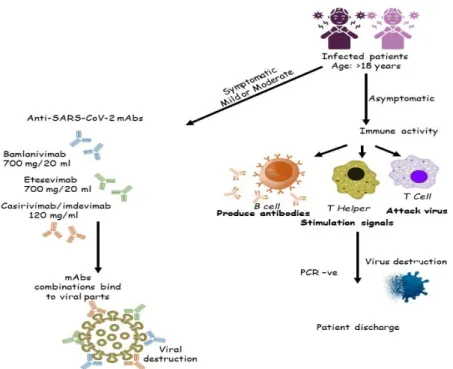
What are the current distribution challenges for the SARS-CoV-2 treatment taken the
- Privacy challenge
- Data Share Issue 47
- Federated Learning (FL)
- Federated Learning for Medical COVID-19 Applications
- Literature survey for Federated Learning in Medical COVID-19 Applications 55
Within these contexts, patient data privacy and the availability of SARS-CoV-2 treatment in delivery hospitals are critical challenges that need to be considered and evaluated. Anti-SARS-CoV-2 MABs are most useful as PEP or treatment for people at high risk of severe infection (Mornese Pinna et al., 2021). The frequency of their use has increased significantly after the outbreak of the SARS-COV-2 pandemic.
To bridge this gap, integration is essential to characterize the supply of anti-SARS-CoV-2 mAbs in distribution hospitals.

Theoretical Background for FDMD Fundamental Solution
- MCDM Methods
- Technique order of preference by similarity to the ideal solution TOPSIS 62
Comparison of alternatives is based on weights and ratios for each criterion (Aruldoss et al., 2013). In contrast, the fuzzy weighted with zero inconsistency (FWZIC) method calculates the weighting constants of criterion with zero discrepancy, regardless of the number of criteria (M. Alsalem et al., 2021). It can determine the importance of criteria in decision-making with the help of experts (M. Alsalem et al., 2021).
However, the original version of FWZC uses triangular fuzzy numbers (M. Alsalem et al., 2021) and thus shows a degree of vagueness and ambiguity.
Data Sets Related to the Covid-19 Studies
In order to test and apply the proposed FDMD, we needed to explore and justify datasets related to the distribution of Covid-19 mAb treatment. In addition, the number of criteria for both the dose of COVID-19 vaccine and plasma transfusion was 5, while the emergency cases of patients with COVID-19 were 4 for moderate grade, 3 for severe grade, and 3 for critical grade. In addition, the scoring process was subjective and objective in the COVID-19 vaccine dose studies and objective only in
According to the expanded data justification, there is no existing infrastructure to collect the data related to COVID-19 treatments.
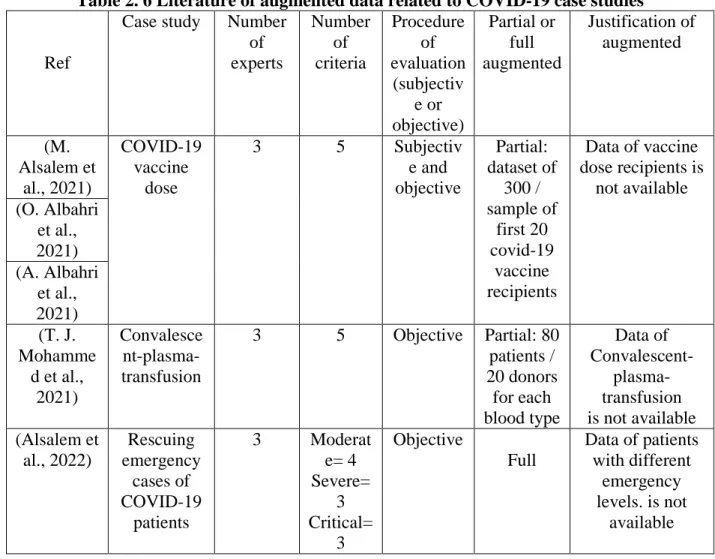
Overview for Validation and Evaluation Procedures in Decision Science
- Systematic Ranking Procedure
- Sensitivity Analysis Procedure
- Comparative study based on Benchmarking checklist Procedure
However, as discussed in the above Table 2.6, the number of experts is the same in all studies in the extended data used in different case studies. A total of 150 alternatives were used by M. The number of alternatives per group was 25 in the study of M. 2021), the number of groups was four and the number of alternatives for each group was 20. In the study by Krishnan et al. 2021), the matrix was based on raw and normalized data.
The type of competition and the number of benchmarking lists per study were discussed.
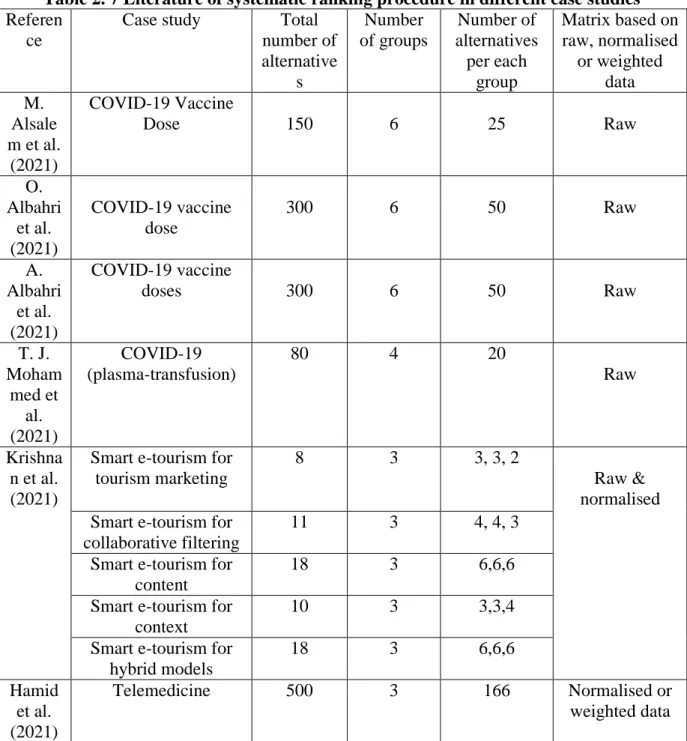
Chapter Summary
In Section 2.8, literature review for validation and evaluation procedure for FDMD Solution is discussed, especially the systematic ranking procedure, sensitivity analysis procedure and comparative study based on benchmarking checklist procedure.
METHODOLOGY
Introduction
Methodology
- Formulated MCDM theory under federated fundamental
- Formulation of IVSH2-FWZIC Weighting Method 79
Experts in this field (researchers and doctors) are identified and selected to assess the importance of the high-risk criteria defined in the first phase. Each expert who has promised to participate in the research receives a form for the assessment of high risk criteria. At this stage, the importance of the high-risk criteria defined for SARS-COV-2 patients is calculated using the procedure formulation of the IVSH2-FWZIC method as presented in Section 3.2.1.1.
Reserve the highest global ranks (i.e. most eligible patients) based on available doses (D) and send an alert to the local machine (K) with the index group pointer of eligible patients (GH_P) for receiving the dose of treatment (TD), referring to equation (17).
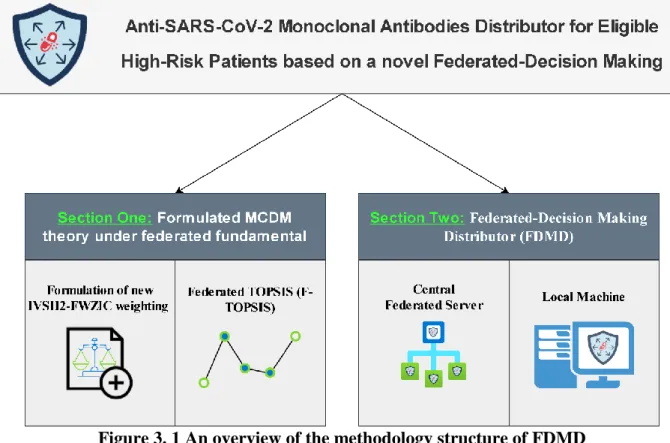
Validation and Evaluation procedures
- Procedure of Sensitivity analysis
- Procedure of Systematic ranking assessment
- Procedure of comparison analysis
In addition, Spearman's correlation coefficient (SCC) will be used to perform a statistical analysis of the correlation between the nine scenarios and the IVSH2-FWZIC ranking results for the local machine. The mean of the 2nd group must then be equal to or higher than the mean of the 3rd group and equal to or less than the mean of the 1st group. The same strategy should be used for the remaining groups, with each group having a mean equal to or higher than that of the next.
In terms of evaluation assessment, the robustness of the proposed method (FDMD) will be presented in section 4.3 compared to the available MCDM method (T. J. Mohammed et al., 2021).
Conclusion
The two main issues of treatment distribution for patients with SARS-CoV-2 across hospital networks will be discussed. These two main challenges will be used as a benchmark checklist for performance comparison from two aspects. First, the application aspect in the medical field, more specifically the available method or procedure in dealing with SARS-COV-2 treatment distribution problems through the hospital network as compared to the proposed one (FDMD), and second, the theoretical aspects, in terms of the challenges in terms of privacy and prioritization.
A summary of the architecture of FDMD mAbs against SARS-CoV-2 in eligible patients is shown in Figure 3.2, and detailed information on the phases is presented in Section 3.2.2.1 and Section 3.2.2.2.
RESULTS AND DISCUSSION
Introduction
Results of High-Risk Criteria Weighting By Using IVSH2-FWZIC
Accordingly, the EDM is built based on Table 3.2 as explained in the third stage and shown in Table A1 in the Appendix. Finally, the final weights for all risky criteria are determined using Equation (5), as explained in stage 5c. The final weights of all risky criteria are listed in Table 4.1, from highest to lowest.
The weighting results of fifteen high-risk criteria based on the extensive IVSH2-FWZIC are shown in Table 4.1. The greatest importance weight (0.1001) was assigned to age (C1), followed by Covid-.
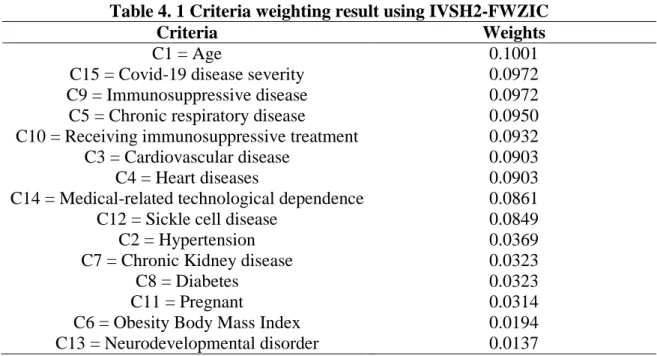
Data Augmentation Results
Cardiovascular diseases (C3) and heart diseases (C4) have the same importance with a weight value of 0.0903. Pregnant (C11) received an important weight of 0.0314, whereas obesity Body Mass Index (C6) and neurodevelopmental disorder (C13) have close weight values of 0.0194 and 0.0137, respectively. The final priority results for the eligible treatment patients can be obtained, as described in section 4.6.
It is worth mentioning that the samples selected from the increased data set of eligible treatment patients will be applied to the proposed DDM as it will be explained in the next section.
The results of evaluation constructed DDM
In addition, the dataset contains a large number of noteworthy cases (alternatives/patients with different high-risk criteria) that can be tested in distributional mechanisms. The DDM is applied to selected cases of treatment-eligible patients from the extended data set (Section 4.3), where each value in the DDM indicated a score of treatment-eligible patients against high-risk criteria. Additionally, zero and one in all other criteria except C15 (ie, severity of Covid-19 disease) represented the presence or absence of the criteria in the patient.
As shown in the following sections, the new MCDM method is able to solve this challenge and provide a prioritization mechanism to prioritize distribution progress.
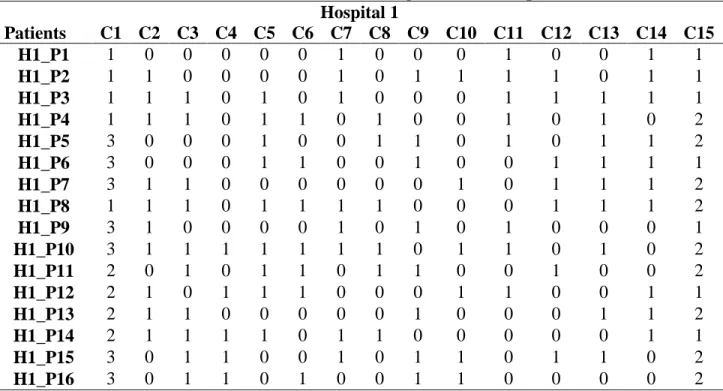
The Positive and Negative Ideal Vector Results
The results of positive and negative ideal vector in LM and CFS for all selected criteria are presented in Table 4.4. As detailed in Section 3.2.1.2, the positive and negative ideal vector results of each hospital are unified in the CFS to determine the federated positive and negative ideal vectors. As can be observed, the federated results of positive and negative ideal vectors are consistent with those of the three hospitals.
The CVS returned the unified positive and negative ideal vectors to each hospital to prioritize eligible treatment patients (section 4.6).
The Results of Patient’s prioritisation at LM using F-TOPSIS
Overall placement results for the qualified treatment patients at each hospital are presented in table 4.5. H1_P6's criteria specifications are related to C1, C5, C6, C9, C12, C13, C14 and C15 (i.e. age, chronic respiratory disease, obesity body mass index, immunosuppressive disease, sickle cell disease, neurodevelopmental disorder, medical-related technological dependence and covid-19 disease severity). The criteria specifications for H2_P9 are related to C1, C2, C3, C4, C7, C9, C10, C11, C12, C14 and C15 (ie age, hypertension, cardiovascular disease, heart disease, chronic kidney disease, immunosuppressive disease, receiving immunosuppressive treatment, respectively pregnant, sickle cell disease, medical-related technology addiction and covid-19 disease severity).
Criteria specifications H2_P13 are associated with C1, C2, C3, C6, C7, C11, C12, C14 and C15 (ie age, hypertension, cardiovascular disease, obesity, body mass index, chronic kidney disease, pregnancy, sickle cell disease , medically related technological addiction or the severity of the disease covid-19).
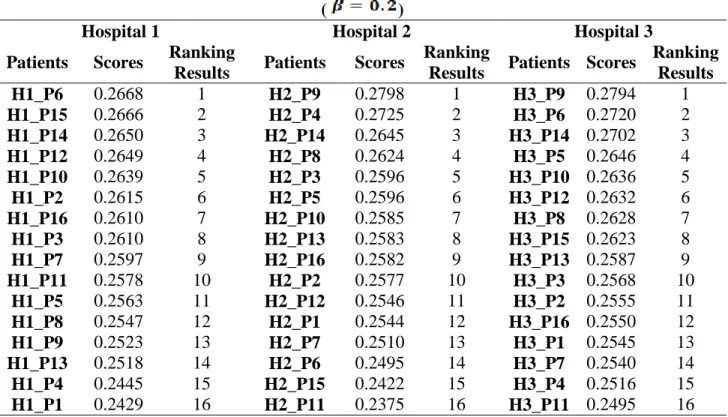
The prioritisation results of the eligible patients in the CFS
Furthermore, the ranking results of the patients are significantly affected by each criterion weight (ie, high-risk criterion). Let's assume that the CFS has seven doses of treatment available and the total number of patients from three hospitals at the CFS is 48 patients. At the CFS, there are three counters of the prioritized patients assigned to each hospital with respect to the available doses (i.e. seven doses), where the first counter represents the patients' number from hospital 1, the second counter represents the patients' number from hospital 2, and the third numerator represents the patients' number from hospital 3.
Therefore, the CFS sent an alert to hospital 1 to start treating the eligible patients (i.e. H1_P6 and H1_P15), hospital 2 to start treating H2_P9 and H2_P4, and hospital 3 to start treating H3_P9, H3_P6 and H3_P14. Those patients represent the top two most eligible patients at hospitals 1 and 2, as well as the top three most eligible patients.
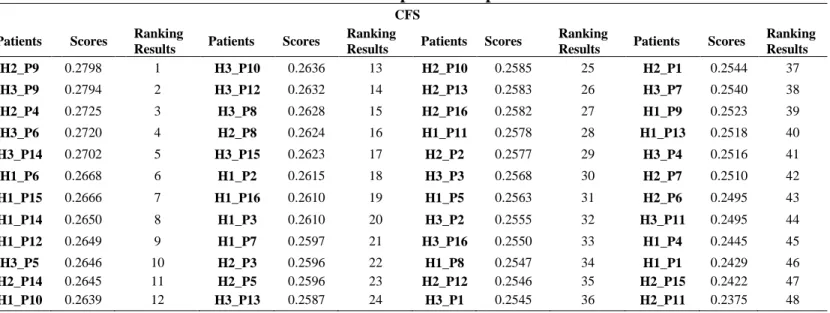
Validation and Evaluation the results
- Sensitivity analysis results
- The results of Sensitivity analysis for the LM 126
- The results of Sensitivity analysis for the CFS 129
- The systematic ranking results for the LM 131
Figures A.1–A.3 in the Appendix show the changing impacts of criteria weights on the queues of patients eligible for treatment. All other patients in hospital 1 changed their ranking relatively, as shown in Figure A.1 in the Appendix. All other patients in hospital 2 relatively changed their rankings as illustrated in Figure A.2 in the Appendix.
Correlation analysis The results for patients ranked at hospital 2 are shown in figure A.5 in the appendix.
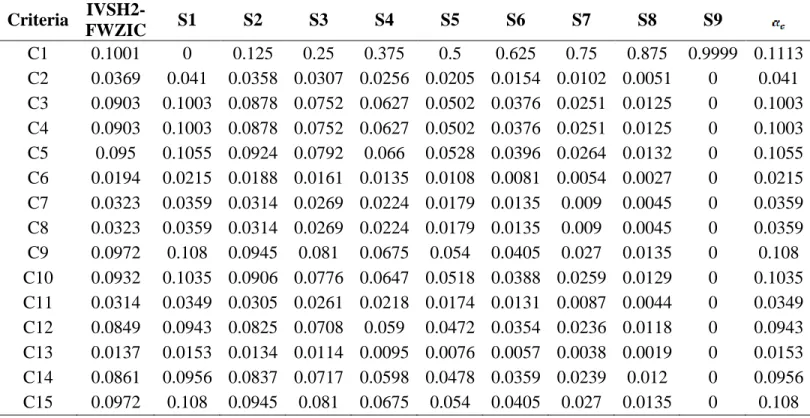
Conclusion
CONCLUSION AND FUTURE STUDY
Introduction
Contribution to the body of knowledge
This study fills the gap of anti-SARS-CoV-2 monoclonal antibody distribution among most eligible patients in hospital networks without sharing patient data records. A dynamic decision matrix is formulated based on the intersection of 'patient' and '15 multiple high-risk evaluation criteria of patient level in mild and moderate cases. A new form of the MCDM method is established based on a federated fundamental called F-TOPSIS to prioritize the most suitable patients under federated environments after a synchronizing sequence process between LM and CFS.
A novel FDMD methodology for federally prioritizing the most appropriate high-risk patients for SARS-COV-2 is developed to overcome two predefined challenges.
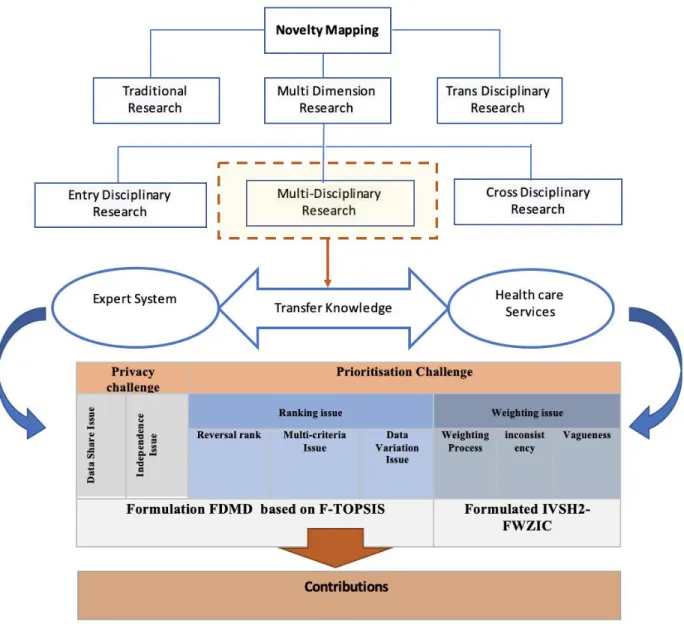
Limitation of the research
A new MCDM weighting method called IVSH2-FWZIC is proposed to determine the importance of criteria that overcomes the vagueness and ambiguity problem.
Future Work
Multi-biological laboratory screening framework for prioritization of patients with COVID-19 based on integrated methods of AHP and VIKOR group. Rescue of emergency cases of COVID-19 patients: An intelligent real-time MSC transfusion framework based on multi-criteria decision-making methods. Decision analysis based on Fermatean fuzzy Yager clustering operators with application to the COVID-19 testing facility.
Case of COVID-19 patients: an intelligent real-time MSC transfusion framework based on multicriteria decision-making methods. Benchmarking method for selecting optimal COVID-19 diagnosis model based on entropy and TOPSIS methods. Based on T-spherical Fuzzy Environment: A Combination of FWZIC and FDOSM for Prioritizing COVID-19 Vaccine Dose Recipients.


